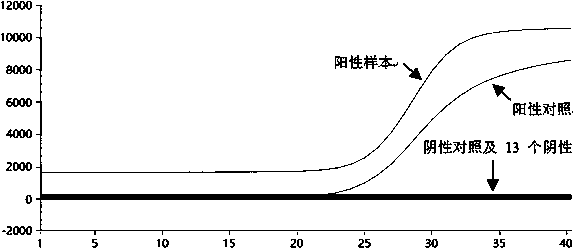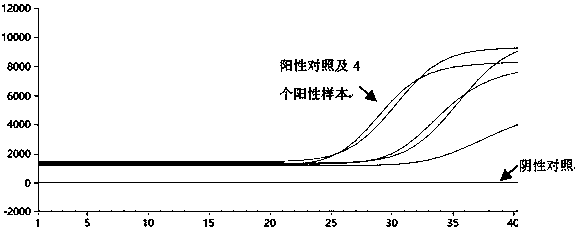Novel coronavirus 2019-nCoV fluorescent RPA detection primers, probe, kit and method
A 2019-ncov, detection kit technology, applied in the field of biotechnology and molecular diagnosis, can solve the problems of cumbersome experimental procedures of thermal cyclers, difficult to meet the detection needs, etc., to reduce experimental time, short detection time period, and high precision Effect
- Summary
- Abstract
- Description
- Claims
- Application Information
AI Technical Summary
Problems solved by technology
Method used
Image
Examples
Embodiment 1
[0029] The development of embodiment 1 fluorescent RPA detection kit
[0030] 1. In this example, select the specific open reading frame ORF1ab gene sequence of the new coronavirus 2019-nCoV to design a pair of specific primers and a specific fluorescent probe, and select the internal standard gene RNase P to design a pair of specific primers And a specific fluorescent probe, the construction of fluorescent RPA technology can detect the new coronavirus 2019-nCoV. The ORF1ab gene is an important structural gene of coronavirus, and the primers and probes designed in the present invention are only 100% similar to the ORF1ab gene of the new coronavirus 2019-nCoV, while other coronaviruses including SARS, MERS, 229E, OC43, NL63 and HKU1 No match, so it can specifically bind and amplify the ORF1ab gene of the new coronavirus 2019-nCoV, but not amplify other types of coronavirus. The primer sequences and probe sequences designed in this example of the present invention are shown in ...
Embodiment 2
[0060] Example 2 Performance test of the fluorescent RPA detection kit for novel coronavirus 2019-nCoV
[0061] 1. Verification of accuracy
[0062] The gold standard for viral nucleic acid detection is genome sequencing. The test results of the secondary kit are compared with the results of viral genome sequencing to analyze its accuracy. In this example, 4 samples determined to be novel coronavirus 2019-nCoV by genome sequencing were selected, and the results after detection with the kit provided by the present invention are shown in Table 3 below. It can be seen that all 4 positive samples were detected, indicating that the accuracy of the novel coronavirus 2019-nCoV fluorescent RPA detection kit provided by the invention is 100%.
[0063] Table 3 Accuracy analysis of the present invention
[0064] Virus type Number of cases Sequencing positive Fluorescent RPA method Accuracy Novel coronavirus 2019-nCoV 4 4 4 100%
[0065] 2. Specificity Ve...
Embodiment 3
[0078] Embodiment 3 clinical experiment
[0079] The above method was used to detect the alveolar lavage fluid, nasal swab, and pharyngeal swab sputum from patients with a positive diagnosis of the new coronavirus 2019-nCoV. The results are as follows: image 3 As shown, the alveolar lavage fluid, nasal swabs, throat swabs, and sputum from patients with a positive diagnosis of the new coronavirus 2019-nCoV all have amplification curves. At the same time, the amplification curves of the internal reference gene RNase P in these samples were normal, as shown in Figure 4 As shown, it shows that the nucleic acid extraction and amplification process of this experiment is normal, and the positive and negative results are accurate. This proves that this method is suitable for the detection of alveolar lavage fluid, nasal swabs, throat swabs, and sputum of patients suspected of novel coronavirus 2019-nCoV infection.
PUM
 Login to View More
Login to View More Abstract
Description
Claims
Application Information
 Login to View More
Login to View More - Generate Ideas
- Intellectual Property
- Life Sciences
- Materials
- Tech Scout
- Unparalleled Data Quality
- Higher Quality Content
- 60% Fewer Hallucinations
Browse by: Latest US Patents, China's latest patents, Technical Efficacy Thesaurus, Application Domain, Technology Topic, Popular Technical Reports.
© 2025 PatSnap. All rights reserved.Legal|Privacy policy|Modern Slavery Act Transparency Statement|Sitemap|About US| Contact US: help@patsnap.com



